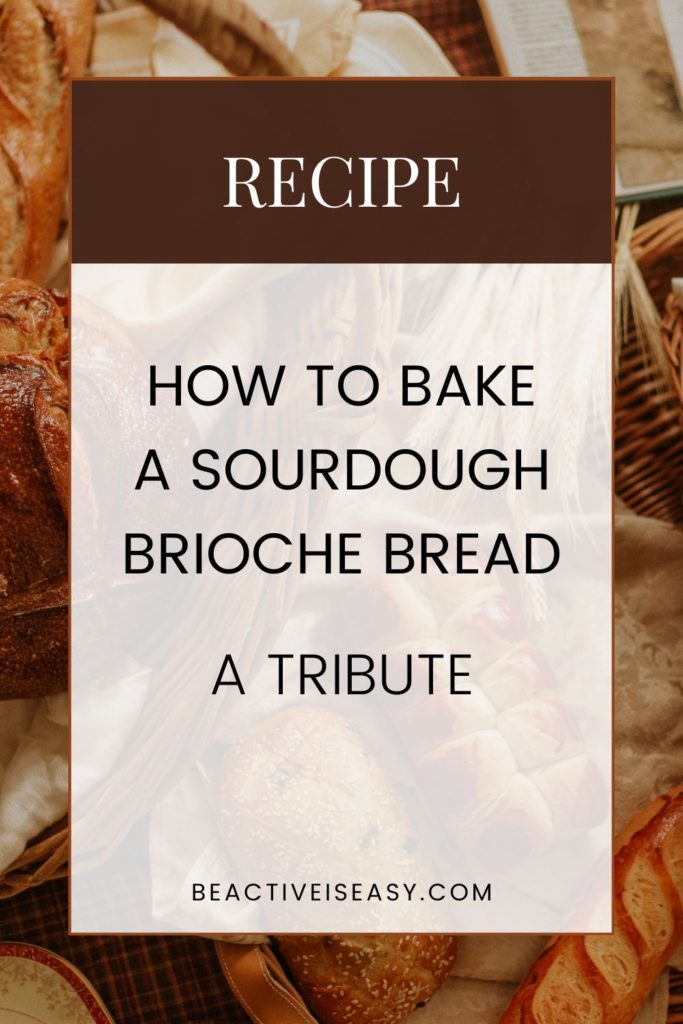A Tribute to a Sourdough Starter – How to Bake Sourdough Brioche Bread
This recipe is a tribute to my sourdough starter – who was alive for more than two years. Thank you very much for reading.
I combined two recipes from Breadtopia[1] and Joshua Weissman[2] to create a fluffy sourdough brioche bread loaf.
You will never need to buy bread OR yeast again once you give this sourdough brioche bread a try! Let us go through all the steps needed down below ↓↓

Summary
Sourdough Starter = Yeast
You need an active sourdough starter to make any sourdough bread. It is what makes your bread fluffy and airy.
You can either make your own from scratch, get a piece from an existing starter, or use a dry sourdough starter from the store.
For full disclosure, I got an instant sourdough yeast package. The product has both industrial yeast AND sourdough starter. The main purpose is for you to make normal yeasted bread that tastes like sourdough bread.
The fun thing is that there is a good dry sourdough starter in the package. All I did was activate this dry yeast into a full-blown active sourdough starter.
How to Make Sourdough Starter
You do not have to be too accurate at this stage. The recipe is super simple. Remember the 2-2-4 ratio. You will need:
- 2 teaspoons of instant sourdough yeast
- 2 tablespoons of bread flour (not bleached)
- 4 tablespoons of purified water (not tap water due to chlorination)
Sourdough starter has living microbes. You do not want to kill them by using ingredients with substances that can hinder their growth, hence, the notes for water and flour.
Once you have everything set, the process is straightforward. Here is a sample schedule you might want to follow:
First day
- mix the instant sourdough yeast, water, and bread flour into a small bowl until everything turns into a paste
- cover lightly for 24 hours
Second day
- scoop about half of what you have and discard
- add 2 tablespoons of water and bread flour and mix
- set aside and cover for another 24 hours
Third day – Seventh day
- repeat the process from the second day
- make sure to check the mixture’s consistency and smell
- you should smell the sourness but not the nastiness of moles
After seven days, you will have an active sourdough starter to use in all kinds of recipes. At this point, you can transfer your active starter into its permanent container so you keep it alive.
How to Use Sourdough Starter
Once you have an active sourdough starter, it is imperative that you keep it alive so that you can keep using it over and over again.
In my case, Sodo the sourdough starter was alive for 16 months! The refeeding process is not hard at all.
The key is to go by texture and taste. You do not even have to measure anything. Keep your purified water and unbleached flour ready.
Everything is low maintenance. I put my sourdough starter in the fridge so I did not need to feed it every day. Here are some pointers:
- Feed the starter every week
- Take roughly half of your mother starter and discard
- Add the same amount (1-to-1) ratio of flour and water and mix
- Continue adding and mixing until the starter looks just a little dry and you can see some white specks
- Let it sit out for 3 hours before putting it back in the fridge
This is your mother sourdough starter. You will not use it for cooking yet. The process detailed above is to maintain the starter alive.
When you are ready to use the starter, use the 1-1-2 ratio for starter, flour, and water. You will need a kitchen scale.
You will need 10 grams of starter and flour with 20 grams of water. Put them all in a bowl (not metal) and mix. Leave the starter to bubble up for at least 2 hours before using.
Related post: How to Meal Prep
How to Make Sourdough Brioche Bread
You have an active sourdough starter! Let us start making an endless amount of bread. No more spending good money on artisan bread.
Note: you will need over 2 days to make the bread. The sourdough starter takes longer to develop than industrial yeast. The butter and eggs in the recipe hinder the development further.
First, create your active sourdough starter by taking some from the mother starter you already develop and keep alive. Follow the 1-1-2 ratio and let it develop for about 3 hours.
One hour before the starter is ready, make the dough. You will need to mix 1000 grams of bread flour and 750 grams of water together. Tap the dough into a bowl and let sit covered.
After an hour, mix your dough and starter together in a stand mixer with the hook attachment. Add water and bread flour as needed.
I found that depending on the humidity, you might need more or less water. It is best to follow the feel of the dough being smooth. Let the dough rest for 1 hour.
Add 5 grams of salt into the dough. Once you see no more salt, add 2 eggs to the dough. You will find it a little wet but keep going, the dough will become one again.
Finally, add one stick of room temperature butter (½ cup) in small pieces of a tablespoon each. The dough will separate again so you need to keep the mixer going.
The blog is long. That is why I created this quick guide for you. It has all the info here but more digestible.
Take the dough out of the mixer and place it into a well-oiled bowl. Let us do some stretches to make sure everything is mixed through thoroughly.
Pull the dough from the middle up, like you are cradling a cat. Let the dough fall through over itself. Turn the bowl to 90° and repeat the process.
You will need to do the stretching and folding every 30 minutes for 2 hours. It can be tedious but the process will ensure the starter and everything else is distributed evenly.
Cover the bowl in between each stretch. I love using a shower cap here. It covers the bowl tightly so no insects can get in while keeping some air circulation for the dough to develop.
After 4 hours, we will divide the dough into 2 equal pieces. Shape them into balls. Have them rest separately for 10 minutes.
Place the balls into your prepared bannetons which should be dusted with all-purpose flour. Cover the bannetons lightly and place them in the fridge for 8 to 12 hours.
Preheat your oven to 500℉. Be sure to place a heat-proof bowl with water inside the oven as well.
You will bake one loaf at a time. Throw your proofed dough into a loaf pan and put it into the oven. Bake for 20 minutes or until you see the dough rise.
Lower the oven temperature down to 430℉ and continue baking for an additional 20 or 30 minutes or until the bread turned brown, or the color you prefer.
Remove the loaf pan to the cooling rack and cool to room temperature. Bake the other loaf in the same manner.
Sample Schedule to Bake Your Sourdough Brioche Bread
1pm: Make your active starter
4pm: Pre-mix water and bread flour together
5pm: Mix dough and starter
6pm: Mix in salt, eggs, and butter
6:30pm: Fold #1
6:45pm: Fold #2
7:00pm: Fold #3
7:30pm: Fold #4
8:00pm: Fold #5
8:30pm: Divide the dough into 2 equal parts and proof in the fridge overnight
~10am next day: Preheat the oven and bake your brioche loaves!
Because it takes so long, it is best that you bake during the weekend. The project is long but it is worth it ✪ ω ✪.
A Tribute to Sodo – the Sourdough Starter
You will find the bread fluffy, full of butter, and tastes just like the store-bought (or even better) version.
There is a faint sour taste but not too overwhelming. Your effort will be worth it.

Thank you very much for reading this article on Sodo and how to bake sourdough brioche bread.
Sodo was my mother sourdough starter and he worked hard to create fluffy bread and pancakes. His passing was a very sad day.
Until now, I am still unsure why, but the time came to get him going. He was 2 years and 4 months old.
Hopefully, through his story and this recipe, you will be inspired to start baking with a sourdough starter, even though you might have missed the sourdough bread pandemic train.
If you wish to have a printout of everything written here, click below ↓↓
Reference sources:


